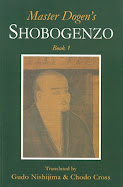"What we call 'Buddhism' might be seen simply as a remarkable collection of stories about practice," writes Barry Gibbs over at his creatively thoughtful blog,
Ox Herding. "If you have an interest in Buddhist teaching, you might try re-telling a story that has meaning for you. My experience suggests that you'll learn more about the teachings. And also about yourself."
Barry was talking about classic Buddhist stories, of course; beloved tales of ancient masters and their bumbling students, etching clarity out of the bricks of our consciousness since the Buddha's fateful date under the Bodhi Tree.
But I've been wanting to address a Buddhist story of a different nature-- a nature, as it turns out, that has been around since
before Buddha's fateful date under the Bodhi tree. I've been wanting to address the issue of Eido Shimano, the Rinzai founder of Dai Bosatsu Zendo and
Zen Studies Society. At issue is the sickening history of Shimano's sexual abuse of his students that has come to full exposure in recent months. Yet what seemed to begin in the summer of 2010 with a
New York Times article actually had been
known since the 1960's-- a reprehensible, irresponsible example of misused power, passing-the-buck and getting off with a slap on the wrist.
Long awed by the marriage of enlightened bliss and the hells of human error, I've followed the tales of the sexual exploits of clergy like something of a press-hound. What began (for me) with the shocking discovery of altar-boy abuse in my (native) Catholic Church expanded with televangelist Jimmy Swaggart's tearful admission in prime-time, "I have sinned." I suppose these things fascinated me because as a girl, I too experienced the most profound betrayal by the misjudgment of an adult whom I was
supposed to trust.
But this time, it's personal. This time the transgressions were committed by a member of my own clergy-- of my
chosen religion, not my ancestral one. This carries an extra weight, for although we know "no one is immune," and never-minding Christian doctrine, Buddhists are supposed to be
peaceful people unhindered by their emotions, right? (...riiiight.) Yet even more profound than this "insult" to my personal spiritual judgment is this: that unlike my childhood betrayal by adults whom I should have been able to trust, Eido Shimano's sexual predation marks a shocking betrayal by an adult whom I had
enlisted to trust*.
So what is a girl to do? Once again, as in childhood, I find myself in a sort of deer-in-headlights situation: if the folks you were supposed to trust turn out to be wholly untrustworthy, and if the folks who support them work as hard as they can to maintain normalcy at the cost of truth (including indirect and watered-down terminology such as
in this address), it begs the question, what
can one trust?
Dharma is what most would answer. And I would tend to agree, because the so-called bedrock of my faith is my own experience-- not what somebody said I would experience. Perhaps Buddha's own final teaching sheds the most light:
Be a lamp unto yourselves. "The truth is out there"-- find your own Bodhi tree, and sit on down.
So this morning I shall follow Barry's good idea and apply an Old Story to a new (?) predicament: my inability to handle Eido Shimano's sexual abuse of his own students in a graceful,
Buddhist way. How shall I address it? By composing my own version of the Eightfold Path, of course. You may find some other wonderful "stories" regarding this dear, elemental teaching on sites I discovered in my research, such as
Handful of Sand and
Explorations and of course good ol'
Wikipedia. But in this moment, the most important teacher I must learn from is the teacher of my own understanding.
1. I see that sexual abuse exists, and I suffer from it because my own hope that one day it will not exist. I cannot change what has already happened, or what will happen again. But I can escape the suffering of it. I will repeat this over and over and over until I finally get it.
2. No, really-- suffering ends. Suffering will end. But I intend to get
beyond suffering. What is beyond suffering? And most importantly-- does "beyond suffering" erase the need for action against the sexual abuse that has been done by Eido Shimano, or anyone else? (..a closer look commences.)
3. First off, I'm thinking, this is a pretty awful situation. An awful lot of people are hurt and stuck and scarred-- the victims, and the perpetrators. Everyone, stuck. Trying in their own way to break free, to get rid of something. To gain something. But I'm going to
say something about it, because to be quiet does no one any good in this situation. Sexual abuse is not acceptable; protecting the perpetrator is not acceptable. Expecting the Dharma to protect or explain is ...missing the point of Dharma. So I am going to say, very
clearly: there is sexual abuse happening. Eido Shimano is abusing his students. People are being hurt. A decisive STOP must be applied.
4. I'm
acting with the clear understanding that by
signing a petition to remove Eido Shimano the abuser, I will help ensure that he does not have access to other potential victims. And I'm signing this online, and writing about it online, so that others may learn about this horrendous activity, pass the word along, and bear witness so a) the perpetrator can get real help, and b) the victims can receive support, in whatever way, in hearing
a chorus of voices say "NO, this is WRONG."
5. I'm going to affirm life by celebrating what is possible: the perpetrator can learn and change; the victims can heal and grow. I'm going to be giving and offer this information very freely: Sexual abuse happened. The perpetrator Shimano must get
real help; the victims
must receive healing. I'm going to honor the body by noting one more time: sexual abuse is wrong in ANY form. And I'm going to honor truth by stating the obvious of that: sexual abuse harms both the abuser (Shimano), and the abused (the
entire Sangha). And I'm going to proceed clearly by saying that again: sexual abuse harms both the abuser, and the abused. What is the "perfection" of this? If both the abuser and the abused can admit that harm has been done, healing can happen. We're all in this boat together: abuser, abused, and witness. Not a single one of us is exempt! We've all got the same chance here to make things right. It's not about being angry: it's about understanding, very clearly, that we're all in this together. We have an amazing opportunity here.
6. It has been an old mistake of mine to 'keep quiet' because of shame, fear, ignorance... But really, who is at fault, ultimately? There is not a single person that I can point a finger to, and hope for some resolution. So my
effort will include all the truths of the matter: we are all in this together, and we must bear the discipline of its address.
7. This address of course begins with me, begins with
my own mind. I must bear the truth of it-- the blamelessness, the urgency-- and attend my actions with the correct spirit. For while it is not imperative that Shimano "do time", it is urgent that Shimano be wholeheartedly helped to understand the fault he has committed. And it is urgent that the victims-- indeed, the whole sangha-- must have their suffering recognized and witnessed.
8. Finally, it is not up to me to cast off suffering. Enlightenment, after all, is not a state of mind: nothing is lacking, nothing needs to be changed. Suffering exists, and
beyond suffering does not mean one ignores suffering. Therefore I approach the very real suffering of Eido Shimano's actions as I approach zazen: knowing full well that my posture and my attitude will be the expression of practice-enlightenment. Not one thing is lacking. I embrace all of it, every part of this wiry self, for the simple reason that there is nothing to do
but live that honesty.
In Gassho,
Pilar Teishin Goldstein-Dea*who is not a "direct" student of Eido Shimano, but an indirect student having read (and learned from) his translations of parts of
Shobogenzo, and nevertheless suffers as directly as
any in our Mahasangha.












